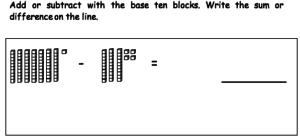Fluently add and subtract within 100 using strategies based on place value, properties of operations, and/or the relationship between addition and subtraction.
Cognitive Complexity Level: 1 – Recall
[divider] [/divider] Students are able to…
- Solve addition and subtraction problems within 100 using a variety of strategies including concrete models, hundreds charts, benchmark numbers, number lines, place value charts, and mental computation.
- Explain strategies for adding and subtracting within 100 and discuss comparisons with peers.
- Write addition equations that could be used to solve subtraction equations.
[divider] [/divider] Students are able to…because teachers:
- Engage students in learning experiences were students model addition and subtraction within 100 using concrete tools and explain how the model connects to written equations.
- Provide students opportunities to model addition and subtraction using open number lines, hundreds chart, and place value charts.
- Facilitate conversations among students where students reason through strategies and make connections between a variety of representations for addition and subtraction within 100.
[divider] [/divider] Questions to ask students:
- How could you draw/show on paper, the addition you did with your base ten blocks?
- Sample answer that indicates understanding: “I can draw a tens and ones chart and place __ lines/rods under the tens and __circles/dots under the ones. Then underneath, I can draw more lines/rods and circle/dots. When I add them together I can add the ones and add the tens to find the sum.”
- How did you decompose the numbers to solve your problem on the open number line?
- Sample answer that indicates understanding: Example 23+35 “I started at 35 because it is the greater addend, then instead of adding all 23 at once, I broke apart the 20 into two tens. I added ten and jumped to 45, then added ten again and jumped to 55. Then I added all the 3 ones and jumped to 58. So 23 plus 35 equals 58.”
- How do you know when you need to regroup?
- Sample answer that indicates understanding: When adding – “If the ones add up to ten or more then I have to regroup them for a ten and some ones. For example, when joining 8 ones with 6 ones it is more than 9, the greatest digit that can go in the ones place, so the amount will form another ten to be recorded in the tens place and some ones that will be represented in the ones place.”
- Sample answer that indicates understanding: When subtracting – “If there aren’t enough ones to subtract from, then I have to regroup tens to ones so that I can subtract. For example, I can’t take away 5 ones from 2 ones, so I regroup the ten into 10 ones and put it together with the 2 ones I had for a total of 12 ones. Now, when I subtract 5 ones from 12 ones it equals 7 ones.”
[divider] [/divider] Additional Resources:
Additional in-depth content knowledge:
http://www.katm.org/flipbooks/2%20FlipBook%20Final%20CCSS%202014.pdf#page=31
Blog Post: Progression of Addition and Subtraction
Video: Teaching the Think-Addition Strategy for Subtraction
Video: Addition and Subtraction with Number Lines
[divider] [/divider] Sample Formative Assessment Task:
[divider] [/divider] Resources/Tasks to Support Your Child at Home:
- LearnZillion Video: Add Within 100 Using Base-Ten Blocks
- LearnZillion Video: Subtract Numbers Within 100 Using Base-Ten Blocks
- Kahn Academy Video: Addition and Subtraction with Number Lines
- Task: Ryan had 62 stickers. His sister had 21 stickers. How many stickers did they have altogether? Can you use a quick pic to show your thinking?
- Task: Solve 54-13. Explain how you could use an open number line to find the difference.
- Task: Solve 39 + 24 on an open number line. Both student and parent solve separately, then compare strategies.

